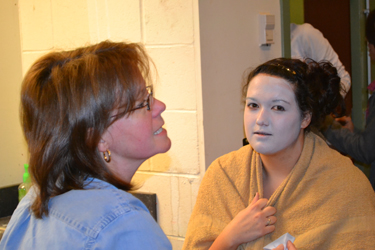
By Ann Needle

Ann Needle
When it comes to Nashoba Regional High School’s fall play, it must be said, just once, that everything old is new again. While the audience may revel at home in the vivid color and images of high-tech televisions, it will need to adjust its mental set to view this weekend’s “We Love Lucy.” Everything — the clothes, the hair, even the grapes to be stomped — is laid out in black and white.
A compilation of seven episodes from the “I Love Lucy” series, the play reflects the black and white era of TV in which the show was produced, from the furniture and props to makeup, and clothes.
It all pays tribute to the deep impression “Lucy” made on American television, with Lucille Ball’s character of 1950s housewife Lucy Ricardo experiencing a variety of antics with husband Ricky and neighbors Fred and Ethel.
The concept for Nashoba’s “Lucy” is the brainchild of Director Bill Grady and Artistic Director Rob Nierintz, the long-time managers of Nashoba Drama’s productions. “I’ve always been a BIG fan of the show,” Grady proclaimed as Nierintz nodded. “I have every one of the episodes at home.”
Several years ago, Grady said he got the notion of reproducing his favorite TV show on the Nashoba stage. Aiming to have the rights in hand for the fall 2011 production — in time for the show’s 60th anniversary — Grady said he wrote to CBS’s legal department, asking what he would need to do.
“We didn’t get a response for months,” Grady recalled. Finally, someone at CBS legal did reply, acknowledging he had a terrific idea. But the person cautioned, “I don’t want to say no, but I would think of something else to do.”
Several more months rolled by before an e-mail finally came in, asking Grady for more details. At that point, Grady had already begun making alternate plans for the fall 2011 production. Regardless, he responded with the details, and as things often happen, a contract arrived from CBS to be signed, after the 2011 alternate plans were set, he said.
As for why CBS relented, Grady said, “From what I could gather, we are a high school production, not a community theater or a bigger group.”
CBS did not charge a lot for all this bother. Niemintz said, “$200 in royalties — that’s it.” Of course, that’s not all. Grady listed some of the many caveats CBS threw into the deal, including keeping any images of Lucille Ball and Desi Arnaz out of any advertising. “Someone there [at CBS] said there are so many hands in the ‘Lucy’ pot,” Grady remarked. “The studio has a stake, Lucille and Desi’s kids have a stake, the writers have a stake.”
The “Lucy” Legacy
Looking back at how deceptively groundbreaking “Lucy” was, it’s easy to see why so many lay claim to the show’s legacy.
Perhaps most well known of the Lucy legacy is that it was the first show to deal with a baby’s birth (Lucy and Ricky’s son) on the air. Not only was the show the first TV series to be filmed live, but Desi Arnaz also insisted it be filmed in Hollywood, were he lived with wife Lucille Ball — something unheard of at the time, Grady said. He added that Arnaz and Ball also were the first to use three cameras, for a more realistic shoot.
In another unusual move, the couple chose to take each episode for storage, which CBS readily allowed. The studio’s attitude to this, according to Grady: “Keep them — who would want to see a TV show a second time?”
Audience-goers this weekend will see seven of the most popular “Lucy” episodes: “Job Switching”, “Lucy Does The Tango”, “Lucy Does A TV Commercial”, “Lucy’s Italian Movie”, “The Diet”, “L.A. At Last”, and “Lucy Goes To The Hospital”. These include many classic “Lucy” scenes, including the snappy chocolate-conveyer belt (with 500 chocolate Dunkin’ Munchkins playing the role of the candy, Grady noted); the stomping of the grapes; and the touting of the virtues of “Vitameatavegamin”. Different actors and actresses will rotate through the main roles of Lucy, Ricky, Fred, and Ethel.
Through the laughter, the audience may be astounded at what it is viewing on a live stage. Anything on stage will be black, white, or gray, playing the variation on those tones. Even the insides of the actors’ mouths will be coated in black food coloring.
In a session that ran more than an hour, Missy Reed of Stow guided volunteers through the painstaking makeup process last weekend, which will include spray-painting everyone’s hair. “You’ll probably pass out after spray-painting them,” Reed only half-jokingly told volunteers. All exposed skin will need to be coated in dark or light gray, or white. Telling the volunteers this, Reed noted that one make-up stick ($15) will take care of about eight actors per show, an estimate that brought small gasps from the group.
Under all that makeup will be Stow actors and actresses Lizzy Amidon, Gwen Burke, Stephanie Dodge, Cam Donahue, Nick Giovinazzo, Ariella Honig, Merisa Kuovo, Peter Lam, Samm McLean, Christian Owen, Marcus Sardella, Marianna Sardella, and Cam Walbridge.
“We Love Lucy” takes place at the NRHS Auditorium on Friday and Saturday, Nov 16 and 17, at 7:30 p.m., and Sunday, Nov 18 at 2 p.m. Tickets are $12 per adult, $10 per student or senior, and can be purchased at the door.